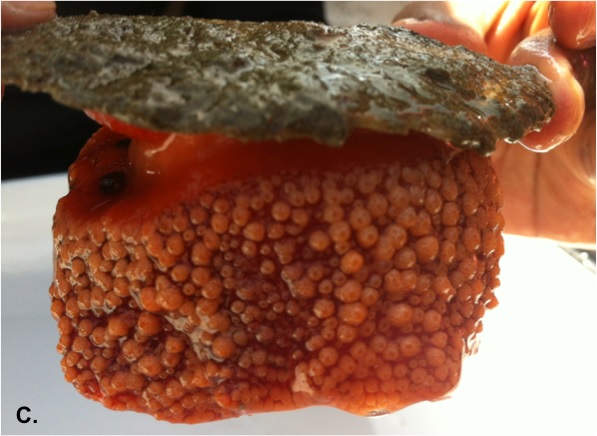Sea grasses, a new unreported habitat for the heterobranch mollusk Umbraculum umbraculum in the Caribbean region
DOI:
https://doi.org/10.47193/mafis.3312020061809Keywords:
heterobranch, habitat, Thalassia testudinum, Colombian CaribbeanAbstract
Herein, a new habitat for the heterobranch mollusk Umbraculum is described. One specimen was found on a Thalassia testudinum bed at Taganga Bay at 3 m depth, a buffer area of the Tayrona National Park, Colombian Caribbean. To the best of our knowledge, these mollusks have not been previously reported in this kind of habitat. Seagrasses may provide protection and possibly serve as areas for its reproduction.
Downloads
References
Ardila N, Báez D, Valdés A. 2007. Babosas y liebres de mar (Mollusca: Gastropoda: Opisthobranchia) de Colombia. Biota Colomb. 8: 185-197.
Arias A, Crocetta F. 2016. Umbraculum Umbraculum (Gastropoda: Heterobranchia) spreading northwards: additional evidence to the “tropicalization” of the Bay of Biscay. Cah Biol Mar. 57: 285-286.
Avila C, Nuñez-Pons L, Moles J. 2018. From the tropics to the poles. Chemical defense strategies in sea slugs (Mollusca: Heterobranchia). In: Puglisi M., Becerro M, editors. Chemical ecology: the ecological impacts of marine natural products. Taylor & Francis Group. p. 71-163.
Bayraktarov E, Pizarro V, Eidens C, Wilke T, Wild C. 2012. Upwelling mitigates coral bleaching in the Colombian Caribbean. Proceedings of the 12th International Coral Reef Symposium, Cairns, Australia. p. 9-13.
Bland LM, Keith DA, Miller RM, Murray NJ, Rodríguez JP. 2016. Directrices para la aplicación de las categorías y criterios de la lista roja de ecosistemas de UICN. Gland: IUCN, Gland, Suiza.
Bode A, Bueno J, Lopez-Urrutia A, Villate F, Uriarte I, Iriarte A, Alvarez-Ossorio M, Miranda A, Casas G, Dos Santos A, et al. 2013. Zooplankton of the Bay of Biscay and Western Iberian Peninsula. In: O’Brien T., Wiebe P., Falkenhaug T, editors. ICES Zooplankton Status Report 2010-2011. International Council for the Exploration of the Sea (ICES). p. 132-160.
Cimino G, Ciavatta M, Fontana A, Gavagnin M. 2001. Metabolites of marine opisthobranchs: chemistry and biological activity. In: Tringali C, editor. Bioactive compounds from natural sources. London and New York: Taylor & Francis Group. p. 577-638.
Cimino G, Crispino A, Spinella A, Sodano G. 1988. Two ichthyotoxic diacylglycerols from the opisthobranch mollusc Umbraculum mediterraneum. Tetrahedron Lett. 29: 3613-3616.
Cimino G, Spinella A, Scopa A, Sodano G. 1989. Umbraculumin-B, an unusual 3-hydroxybutyric acid ester from the opisthobranch mollusc Umbraculum mediterraneum. Tetrahedron Lett. 30: 1147-1148.
Diaz-Pulido G, Garzon-Ferreira J. 2002. Seasonality in algal assemblages on upwelling-influenced coral reefs in the Colombian Caribbean. Bot Mar. 45: 284-292.
Diaz J, Puyana M. 1994. Moluscos marinos del Caribe Colombiano: un catálogo ilustrado. Bogotá: Fundación Natura. 291 p.
Faulkner D, Ghiselin M. 1983. Chemical defense and evolutionary ecology of dorid nudibranchs and some other opisthobranch gastropods. Mar Ecol Prog Ser. 13: 295-301.
Marcus E, Marcus E. 1967. Opistobranchs from the southwestern Caribbean sea. Bull Mar Sci. 17: 597-628.
Mikkelsen P. 2002. Shelled opisthobranchs. In: Southward AJ, Tyler PA, Young CM, Fuiman LA, editors. Advances in marine biology, molluscan radiation lesser-known branches. Vol. 42. San Diego: Academic Press. p. 67-136.
Pawlik JR. 1998. Coral reef sponges: do predatory fishes affect their distribution? Limnol Ocean. 43: 1396-1399.
Pawlik JR, Loh TL, McMurray SE. 2018. A review of bottom-up vs. top-down control of sponges on Caribbean fore-reefs: what’s old, what’s new, and future directions. PeerJ. 6: e4343. DOI: https://doi.org/10.7717/peerj.4343
Sankar R, Raja P, Murugan A. 2011. Occurrence of opisthobranch mollusc Umbraculum umbraculum in Tuticorin coast, Southeast coast of India. Indian J Mar Sci. 40: 487-490.
Vergés A, Steinberg P, Hay M, Poore A, Campbell A, Ballesteros E, Heck K, Booth D, Coleman M, Feary D, et al. 2014. The tropicalization of temperate marine ecosystems: climate-mediated changes in herbivory and community phase shifts. Proc R Soc B. 281: 20140846. DOI: https://doi.org/10.1098/rspb.2014.0846
Wägele H, Ballesteros M, Avila C. 2006a. Defensive glandular structures in opisthobranch molluscs-from histology to ecology. Oceanogr Mar Biol. 44: 197-276.
Wägele H, Vonnemann V, Rudman WB. 2006b. Umbraculum umbraculum (Lightfoot, 1786) (Gastropoda, Opisthobranchia, Tylodinoidea) and the synonymy of U. mediterraneum (Lamarck, 1812). Rec West Aust Museum. 69: 6982.
Willam RC. 1984. A review of diets in the Notaspidea (Mollusca: Opisthobranchia). J Malacol Soc Aust. 6: 125-142.

Published
Issue
Section
License
Copyright (c) 2020 Erika García-Bonilla , Paula González , Laura Pirateque , Jüergen Guerrero-Kommritz , Mónica Puyana , Alberto Acosta

This work is licensed under a Creative Commons Attribution-NonCommercial-ShareAlike 4.0 International License.
Authors of articles published in Marine and Fishery Sciences retain copyright on their articles, except for any third-party images and other materials added by Marine and Fishery Sciences, which are subject to copyright of their respective owners. Authors are therefore free to disseminate and re-publish their articles, subject to any requirements of third-party copyright owners and subject to the original publication being fully cited. Visitors may also download and forward articles subject to the citation requirements. The ability to copy, download, forward or otherwise distribute any materials is always subject to any copyright notices displayed. Copyright notices must be displayed prominently and may not be obliterated, deleted or hidden, totally or partially.
This journal offers authors an Open Access policy. Users are allowed to read, download, copy, distribute, print, search, or link to the full texts of the articles, or use them for any other legal purpose within the Creative Commons 4.0 license (BY-NC-SA), without asking prior permission from the publisher or the author. This is in accordance with the BOAI definition of Open Access.























